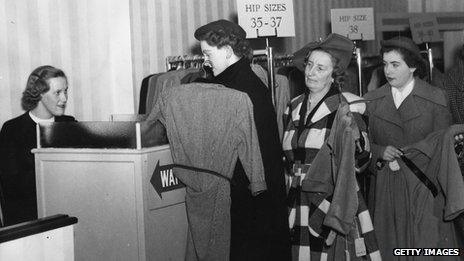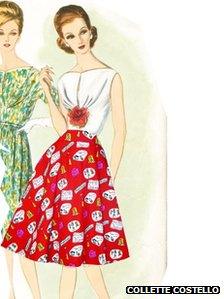Vintage style: The rise of retro fashion
- Published

Is vintage becoming a victim of its own success?
Cupcakes, bunting and pre-loved treasures coming to a village hall near you soon.
The rise of vintage from fashion to furniture has been well documented on blogs and in the <link> <caption>media</caption> <url href="http://www.guardian.co.uk/fashion/fashion-blog/2012/mar/28/charity-shops-thrive-during-recession?INTCMP=SRCH" platform="highweb"/> </link> .
But as more businesses rebrand second hand as shabby chic will retro style fall out of favour?
"Even if you go back two or three years you used to get real bargains. You could bid on old furniture on eBay and get it for 99p, now the same items are £60 or £70," says Estelle Riley.
Ms Riley sells "shabby chic" furniture and accessories in the West Midlands through the business she co-owns, The Secret Garden.
But recently the popularity of vintage has caused its own problems.
"We used to go to charity shops and pick up furniture for next to nothing but you can't do that now," she said.

The 1950s were characterised by fun fashion trends
Initially people bought second-hand furniture and restored it because it was all they could afford.
But then they began to like the old-fashioned look and sought out pieces that could be painted or distressed to recreate the vintage look at home.
And despite the challenges in seeking out a bargain she believes vintage is still on the rise.
"We only set up the business in February but we've noticed vintage fairs are becoming really popular," she said.
But vintage could become a victim of its success, according to Collette Costello.
The Manchester-based designer creates clothes and bags based on designs from the past.
She said: "The market is becoming a bit saturated. Quite often an event will say it is vintage but you go along and see they've adopted the word vintage to sell second hand."
Vintage is defined as representing the high-quality products of the past such as designer clothing or classic cars - but to many it has become a catch-all term for anything that looks old - even if the item itself is new.
'Become wise'
"I sell stuff which is in the style of vintage but everything I make is brand new. Too many people are taking shoddy goods and selling them as vintage - the quality is going down," she said.
"Consumers won't be interested in two years time as prices go up and people become wise to it."
Charity Oxfam launched its vintage section online and saw sales through its website shoot up by 400%.

Collette Costello thinks the vintage market is becoming saturated
The service, which allows Oxfam's 700 shops to post vintage items for sale online, was set up three years ago after the charity noticed more people were typing the word "vintage" into the website's search box.
Caroline Swarbrick, Oxfam's trading events manager, said the charity ensured volunteers knew what genuine vintage was and did not label things as vintage if they were just second hand.
"We're really careful to talk to our volunteers and tell them retro means retrospective, so it's made in the style of a certain era, whereas vintage is anything over 20 years old, so no later than the 80s.
"If it's over 100 years old then it's antique."
Just three weeks ago the website recorded its highest ever sales turning over £4,000 in one week.
The charity even has a vintage shop in Manchester - Oxfam Originals - and boutiques scattered around the UK which sell vintage goods.
Whether vintage is still on the rise or starting to decline, everyone agrees items from the 1950s are still the biggest draw for those seeking an escape from economic doom and gloom.
Ms Costello said: "A lot of fabric was used in skirts and the quality was high - shops wouldn't make skirts like that now because they would cost too much money.
"There was an exuberance about the 50s. After the war people didn't take things too seriously - we look back on it as a more fun time."
Catherine Wright thinks another reason for the appeal is the hourglass shape of 1950s women's clothing.
The vintage boutique owner, who sells clothes and collectibles from her Southampton shop, said: "If you look at High Street fashion it's been slouchy sportswear for a long time.
"Fashion very naturally swings and it was time for the look to come back.
"The 50s style speaks very much to women's endless fixation on body shape - it's very appealing to wear a big skirt that can make your bottom go away."
But despite the rise of vintage threatening to flood the market, she said she was not concerned.
"It's kind of inevitable that the bubble will burst but vintage will still be here because people will still be interested in beautiful old things."
- Published5 April 2012
- Published27 March 2012